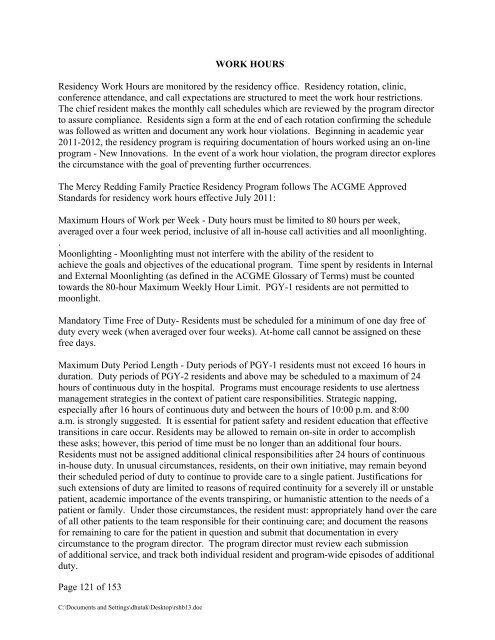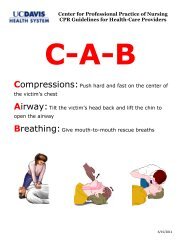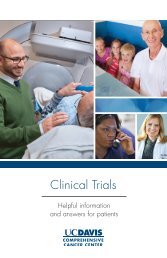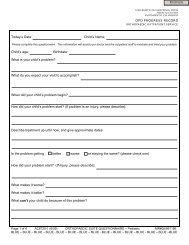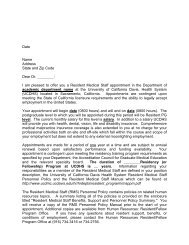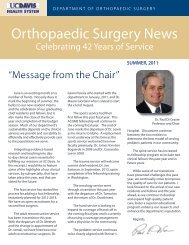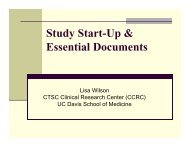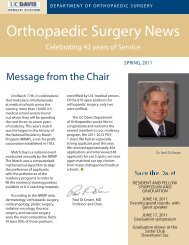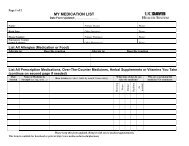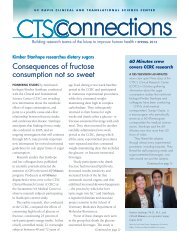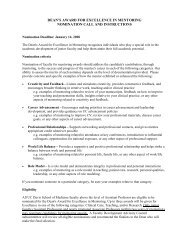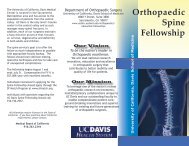Resident Handbook - UC Davis Health System
Resident Handbook - UC Davis Health System
Resident Handbook - UC Davis Health System
- No tags were found...
You also want an ePaper? Increase the reach of your titles
YUMPU automatically turns print PDFs into web optimized ePapers that Google loves.
Page 121 of 153WORK HOURSResidency Work Hours are monitored by the residency office. Residency rotation, clinic,conference attendance, and call expectations are structured to meet the work hour restrictions.The chief resident makes the monthly call schedules which are reviewed by the program directorto assure compliance. <strong>Resident</strong>s sign a form at the end of each rotation confirming the schedulewas followed as written and document any work hour violations. Beginning in academic year2011-2012, the residency program is requiring documentation of hours worked using an on-lineprogram - New Innovations. In the event of a work hour violation, the program director exploresthe circumstance with the goal of preventing further occurrences.The Mercy Redding Family Practice Residency Program follows The ACGME ApprovedStandards for residency work hours effective July 2011:Maximum Hours of Work per Week - Duty hours must be limited to 80 hours per week,averaged over a four week period, inclusive of all in-house call activities and all moonlighting..Moonlighting - Moonlighting must not interfere with the ability of the resident toachieve the goals and objectives of the educational program. Time spent by residents in Internaland External Moonlighting (as defined in the ACGME Glossary of Terms) must be countedtowards the 80-hour Maximum Weekly Hour Limit. PGY-1 residents are not permitted tomoonlight.Mandatory Time Free of Duty- <strong>Resident</strong>s must be scheduled for a minimum of one day free ofduty every week (when averaged over four weeks). At-home call cannot be assigned on thesefree days.Maximum Duty Period Length - Duty periods of PGY-1 residents must not exceed 16 hours induration. Duty periods of PGY-2 residents and above may be scheduled to a maximum of 24hours of continuous duty in the hospital. Programs must encourage residents to use alertnessmanagement strategies in the context of patient care responsibilities. Strategic napping,especially after 16 hours of continuous duty and between the hours of 10:00 p.m. and 8:00a.m. is strongly suggested. It is essential for patient safety and resident education that effectivetransitions in care occur. <strong>Resident</strong>s may be allowed to remain on-site in order to accomplishthese asks; however, this period of time must be no longer than an additional four hours.<strong>Resident</strong>s must not be assigned additional clinical responsibilities after 24 hours of continuousin-house duty. In unusual circumstances, residents, on their own initiative, may remain beyondtheir scheduled period of duty to continue to provide care to a single patient. Justifications forsuch extensions of duty are limited to reasons of required continuity for a severely ill or unstablepatient, academic importance of the events transpiring, or humanistic attention to the needs of apatient or family. Under those circumstances, the resident must: appropriately hand over the careof all other patients to the team responsible for their continuing care; and document the reasonsfor remaining to care for the patient in question and submit that documentation in everycircumstance to the program director. The program director must review each submissionof additional service, and track both individual resident and program-wide episodes of additionalduty.C:\Documents and Settings\dhutak\Desktop\rshb13.doc


